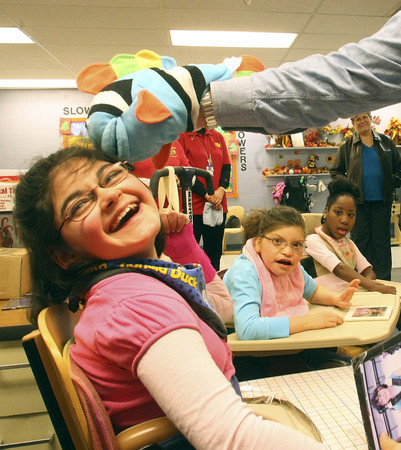In this school, seemingly small steps are huge Educators at John F. Miller teach students with multiple handicaps
Lauren Pelicano suffered a massive brain hemorrhage a few days after birth. As a result, she lives with epilepsy, cerebral palsy and the danger of spinal fluid accumulating in her brain.
With limited control over her body, Lauren "can't stand, she can't even crawl," said her mother, Brenda Pelicano.
But Lauren attends school every day just like any other 13-year-old. She goes to John F. Miller School, which serves the most medically fragile students in the Clark County School District.
Because students have multiple handicaps, few can walk, talk or even hold a pencil. None is toilet trained.
Students range in age from 3 years old to a day before their 22nd birthday, when they become ineligible for public education, but school official say the average student functions at the level of a baby 6 months to 9 months old.
The school at 1905 Atlantic St. employs 10 full-time nurses who perform 165 different medical procedures, including hooking up students to feeding tubes.
Some classrooms look more like hospital rooms in a pediatrics ward.
Occupational therapists stretch kids over giant rubber balls to develop their muscles.
The district spend $38,998 a year per student at the school, which compares to the district average of $7,546.33 per student.
For transportation, Miller has 30 buses for its 125 students, but field trips are out of the question for financial, logistical and liability reasons. The school does not want to expose children to any unnecessary risks, Principal Jean Reynolds-Trudell said.
But there's no lack of confidence in the children's ability to learn.
Experience has taught teachers never to underestimate their students.
"I will tell you one of the things I will never forget is a parent telling me, 'I never thought I would hear my child tell me they loved me,' " Reynolds-Trudell said.
Gadgets called "switches" have made it easier for the kids to communicate. By pressing down on command keys, they can play recorded statements such as "I'm sick of this TV show" or "I'm hungry."
Students from other schools record their voices for the "switches" so the audio will sound like children.
Irene Wells, a teacher at Miller since 1991, said, "The whole object is so they can have quality of life, so they can tell us what they want."
Her students are "strapped down all day in chairs," Wells added. "If they have an itch, they can't (always) tell you that," she said.
School officials estimate that 80 percent of students can communicate at least at the minimum level of indicating "yes" or "no." Getting the students to this point can take years of practice and patience.
"We try to find a communication system for each child," the principal said.
"It can take many years," Reynolds-Trudell said. "Many of students come to us not having the basic understanding of cause and effect."
For example, Wells is working on making eye contact with one girl in a class for 11 to 13 year olds.
"She's actually moving her head," she said. "I got her to look up and say 'Yes' once, which is huge. If you can get them to say yes and no, that is huge."
Wells has worked with one girl for six years to get her to understand the command keys on her switch box.
"It's not an easy process," Wells said.
"By holding down one button, she can say, 'Today is Tuesday,' (but) she has to hold this (button) down to go to the next (day). We're still working on that."
Teachers at Miller are like explorers of uncharted territory.
"There's real no curriculum for our students," Reynolds-Trudell said. "Our teachers are real creative. You can't buy packaged curriculum."
Classrooms have lots of toys, from stuffed animals to Spider-Man, to engage students' interest.
Wells likes to play a game where her students must choose between two puppets in Wells' hands, a peaceful fish and a crazy bird.
If they choose the fish, they get gentle kisses from the puppet. If they choose the bird, Wells will playfully bop them with it.
Wells said she exaggerates the differences in their puppets' behavior because "everything is thing about learning to make a choice."
Brenda Pelicano, the mother of Lauren, said she is pleased her daughter gets lots of attention.
"She actually comes home very tired, yet very stimulated from the day," the mother said.
She believes Wells does a fabulous job of "pushing them a little bit to achieve more than what they can do, working toward skills they might not achieve but could, she sees the potential in them."
The feeling is mutual for Wells. She said she's encouraged by her students' confidence in her.
"I fell in love with these kids," Wells said. "You cannot not love these children. They never complain. They work really hard.
"They never stop trying. They strive to help you teach them how to communicate."
Contact reporter James Haug at jhaug@reviewjournal.com or 702-374-7917.
View the slide show


















